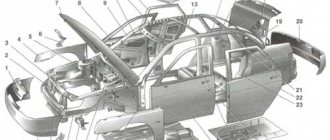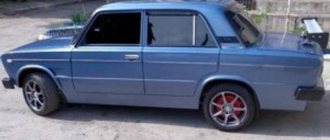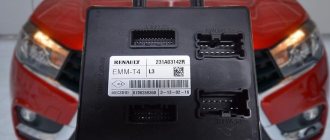VAZ 2106 body dimensions
How much does the VAZ 2106 body weigh and what are its dimensions? People often ask on forums and car portals. Indeed, interest in the most popular car in the post-Soviet space was and remains incredibly high. Find out more by reading useful information on the body of this car. A lot depends on how much the body of the VAZ 2106 weighs, including the condition of the main parameters of the car.
Body
| Number of doors | 4 |
| Number of seats | 5 |
| Wheelbase | 2424 mm |
| Front track | 1365 mm |
| Rear track | 1321 mm |
| Ground clearance | 170 mm |
| Maximum trunk volume | 345 l |
| Width | 1611 mm |
| Length | 4166 mm |
| Height | 1440 mm |
This is interesting: When to change spark plugs on a Mercedes
Engine
| Engine capacity | 1569 cm3 |
| Power | 75 hp |
| At rpm | 5400 |
| Torque | 116/3000 n*m |
| Gas distribution mechanism | OHC |
| Number of cylinders | 4 |
| Number of valves per cylinder | 2 |
| Cylinder diameter | 79 mm |
| Piston stroke | 80 mm |
| Compression ratio | 8.5 |
Do-it-yourself engine tuning 2106
Increasing the engine capacity of the VAZ 2106
For all owners, sooner or later, the standard 75 power ceases to be enough, the car begins to seem sluggish, unresponsive, and the question arises of how to increase the power of the 2106 engine. The most economical and simple tuning is to bore the VAZ 2106 engine by 3 mm for an 82 mm piston. Sharpening will no longer be possible, the walls of the block become very thin, only the sleeve of the block remains. To obtain a more torquey engine and further increase the volume to 1.8 liters. you need to increase the piston stroke to 84 mm. Otherwise, the modernization, modification and boost of the 2106 1:1 engine repeats the modification of the 2103; we read about installing shafts HERE.
Engine from Priora to VAZ 2106
Do you have an extra prioromotor lying around in the garage? Don’t rush to send it to the landfill, there is a better idea. Installing a 16 valve engine on a VAZ 2106 is one of the best ways to get reliable 100 hp, but at the same time the procedure is quite difficult, you will have to saw the engine shield with a grinder, digest the pan, install the crankshaft bearing 2101 on the eight-wheel, the original gearbox remains, the clutch is changed to Priorovskoe. In addition, the flywheel, exhaust system, cooling system and accelerator drive will require improvements. Doesn't it scare you? Then it's worth a try. Materials with step-by-step photo reports are widely available and will not be difficult to find. The situation is similar with the 2112 engine on the VAZ 2106; in any case, such a swap is better than squeezing the juices out of an old classic engine. All this can be done with Niva 1.7 and 1.8
Body weight
Let’s say right away that the “six” weighs exactly 1045 kg. Its mass is decomposed as follows:
- The weight of the power unit together with additional equipment is 140 kg;
- The gearbox weighs about 26 kg;
- Shaft – 10 kg;
- Rear axle – 52 kg;
- Radiator – 7 kg;
- Body – 280 kg.
VAZ 2106 body weight
It turns out that the body is the heaviest part of the car. It is exactly twice as heavy as the engine. The remaining parts of the machine have approximately the same mass.
How much does the VAZ weigh?
Perhaps one of the most popular cars in the post-Soviet space was, is and remains the VAZ.
This car has captivated many generations. However, how did it all begin? When was the first VAZ car produced and how much did it weigh? You will learn the answers to these and other questions from this article. The first VAZ car was produced by the Volzhsky Automobile Plant on April 19, 1970. The make of this car was VAZ-2101 Zhiguli. Its production was carried out according to the analogue of the Fiat concern. Moreover, VAZ owes its appearance to this particular brand of Fiat 124, produced in 1966. Here, in fact, is it:
As a result of some design improvements, the first domestic car, the VAZ 2101 of 1970, was produced:
The weight of this car was 955 kg. Moreover, of this mass the engine weighed 114 kg.
It has not lost its popularity to this day. In 2000, it was recognized as the best car among eighty thousand car enthusiasts surveyed in the CIS countries and Russia. It was named the best car of the century, VAZ 2101. At the time of its production, it was considered the most comfortable, reliable and modern domestic car. Its presence was a sign of wealth and prosperity!
But the Volzhsky Automobile Plant did not stop there. He created entire collections of this car. Each of them differed in its configuration, as well as its total weight. Therefore, now we will compare some VAZ models by their weight.
- VAZ 2102 has a weight of 1010 kg .
- VAZ 2103 has a weight of 965 kg .
- VAZ 2104 has a weight of 1020 kg .
- VAZ 2105 has a weight of 1060 kg .
- VAZ 2106 has a weight of 1045 kg .
- VAZ 2107 weighs 1049 kg .
- VAZ 2108 weighs 945 kg .
- VAZ 2109 weighs 915 kg .
- VAZ 2110 has a weight of 1020 kg .
- VAZ 2111 has a weight of 1055 kg .
- VAZ 2112 has a weight of 1060 kg .
- VAZ 2113 weighs 975 kg .
- VAZ 2114 weighs 985 kg .
- VAZ 2115 has a weight of 1000 kg .
- VAZ 2116 weighs 1276 kg .
- VAZ 2117 has a weight of 1110 kg .
- VAZ 2118 has a weight of 1110 kg .
- VAZ 2119 has a weight of 1110 kg .
- VAZ 2120 has a weight of 1110 kg .
- VAZ 2121 has a weight of 1550 kg .
- VAZ 2122 has a weight of 1122 kg .
- VAZ 2123 has a weight of 1300 kg .
But this is the total weight of a VAZ car. As for some parts of the car, the weight of, for example, a VAZ 2106 can be decomposed as follows:
- The weight of the engine with equipment is 140 kilograms .
- The weight of the gearbox is 26 kilograms .
- The weight of the square shaft is 10 kilograms .
- The weight of the rear axle is 52 kilograms .
- Radiator weight – 7 kilograms .
- Body weight – 280 kilograms .
On average, the weight of all components of a VAZ car has approximately the same mass. Throughout the entire period of existence of this car, quite interesting facts have been recorded that simply cannot be ignored. It’s hard to imagine that a car weighing an average of 1 ton is very popular.
So, the VAZ 2121 Niva car is not only the most popular throughout the USSR, but also the most exported. Just imagine, this model was produced in 1.8 million cars. And of this amount, 500,000 were sold to more than 100 countries. As we remember, the weight of the VAZ 2121 is 1550 kilograms . This means that over the entire period, 775,000,000 kilograms of this car were sold! Also, this particular model of all Soviet cars was driven in Japan. As for the design of the VAZ 2108, it was developed by the currently well-known company Porshe. Its engine weighs 127.3 kilograms . This became necessary due to the fact that the demand for this brand of car was greatly reduced. For this reason, they decided to modernize it.
Moreover, the VAZ car became more popular because the Lada car was the first car of the famous Formula 1 racer - Kimi Raikkonen. His father loved this car extremely much for its reliability.
So, we learned that each VAZ car model has its own separate weight. But throughout the history of its existence and production, it has not undergone major changes.
Performance indicators
| Maximum speed | 150 km/h |
| Acceleration time (0-100 km/h) | 17.5 s |
| Fuel consumption in the city per 100 km | 10.1 l |
| Fuel consumption on the highway per 100 km | 7.4 l |
| Combined fuel consumption per 100 km | 10.1 l |
| Fuel tank volume | 39 l |
| Vehicle curb weight | 1035 kg |
| Permissible gross weight | 1435 kg |
| Tire size | 175/70 SR13 |
Vehicle specifications
| Vehicle weight (fully equipped), kg | 1045 |
| Payload, kg | 400 |
| Permissible maximum weight, kg | 1445 |
| Ground clearance (front/rear), mm | 175/170 |
| Permissible weight of cargo in the luggage compartment, kg | 50 |
| Maksim. speed (with permissible total cargo weight - 150 kg, with a driver and one passenger), km/h | 152 |
| Acceleration time to 100 km/h (with a permissible total cargo weight of 150 kg, with a driver and one passenger), s | 17,2 |
| Acceleration time to 100 km/h (with driver and one passenger), s | 16 |
| Fuel consumption per 100 km at speeds: 90-120 km/h highway/city, l | 10,1/10,3 |
| Stopping distance with the highest permissible weight during sudden braking (80 km/h), m | 36 |
Other
VAZ 2106 2106 1.6 MT is a 4-door car with a 4-speed gearbox. With the number of seats for the driver and passengers: 5. The maximum permissible speed is 150 km/h. Acceleration time to 100 km/h is 17.5 s. Average fuel consumption per 100 km is: in the urban cycle - 10.1 liters, on the highway - 7.4 liters, in the combined cycle - 10.1 liters. Maximum fuel tank volume is 39 l. A full tank is enough for approximately: 386 km when driving around the city, 527 km when driving on the highway, 386 km when driving the combined cycle. The maximum load capacity of the vehicle is 400 kg.
- Fuel consumption VAZ 2106
- Maximum speed of VAZ 2106
- Dimensions and dimensions of the VAZ 2106
- Acceleration to 100 km/h VAZ 2106
This is interesting: Where is the VIN code of the car in the documents?
Dependence of driving characteristics on dimensions and weight
A classic method of improving the traction and dynamic characteristics of a vehicle is to properly distribute the weight of both the vehicle itself and the luggage it carries. Speed tests have shown that rear-wheel drive cars (which is the VAZ 2106) when accelerating, shift part of the weight from the center of the car and the front axle to the rear. The latter leads to a greater load on the rear side of the chassis, which is an auxiliary effect when driving. This is due to an increase in the contact patch and an increase in the coefficient of adhesion of the tire to the road surface.
The standard dimensions and weight of the vehicle allow you to transport up to 150 kilograms of luggage or any other cargo. Weight up to 400 kilograms does not affect the dynamic performance of the car in any way. Achieving a maximum speed of 152 km/h is possible when fully loaded with luggage, driver and passengers. With the previous parameters, reaching the speed mark of 100 km/h is achieved in 17.2 seconds. If you have luggage weighing up to 150 kilograms, the amount of gasoline consumed per 100 kilometers at a speed of 90 km/h is ten liters and one hundred grams.
But no matter how much you reduce the weight of a vehicle, it will not be possible to increase power. Reducing the weight of the VAZ 2106 car and modernizing its body components will help improve dynamic characteristics. This can be achieved without changing the design of the body, power or traction units in the following ways.
- Do not drive a car with a full tank of fuel, do not add fluid to the windshield washer reservoir. The weight of a full fuel tank is more than eighty kilograms, and the windshield washer tank weighs up to ten kilograms.
- Forged wheels lead to the loss of 10–20 extra pounds.
- Upgrading the suspension, replacing steel levers with aluminum ones, the overall dimensions of which are suitable, will reduce the weight by another couple of kilograms.
- How much will replacing the muffler cost? About 25–30 kilograms.
- Modernization of non-load-bearing streamlined parts of the car body will help to improve the aerodynamic properties of the car, provided that the dimensions of the car remain unchanged.
The above methods for making a car lighter are not the only or unique ones. How many are there? Yes, a lot. However, the fact that the VAZ 2106 weighs less affects not so much the speed indicators as the braking characteristics, handling, etc.
It is worth remembering that serious unskilled intervention in the design of a car without the appropriate equipment leads not so much to an improvement of the car, but to a deterioration in the quality of the vehicle, a decrease in the operating time of the car, as well as a threat to the health and life of the driver, passengers and other road users .
How much does the VAZ 2106 body weigh and what are its dimensions? People often ask on forums and car portals. Indeed, interest in the most popular car in the post-Soviet space was and remains incredibly high. Find out more by reading useful information on the body of this car. A lot depends on how much the body of the VAZ 2106 weighs, including the condition of the main parameters of the car.
Body dimensions of the “six” and their verification
VAZ 2106 geometric dimensions of the body
There is a concept of car body size. Along with this, it is customary to talk about geometric dimensions, which imply control standards and distances, the geometry of door and window openings, the distance between axes and much more.
As a rule, a car that has been in an accident is checked for displacement of the main body elements. Particular attention is paid to the following body parts:
- Diagonals. The car is driven onto the overpass, and then the distance from one extreme point of the floor to the other is checked diagonally using a tape measure. If there is a discrepancy between the distances on one side and the other, there is movement of the body;
- Racks. They are subject to mandatory verification. First of all, if the car has been in an accident, the whole side, not damaged, is diagnosed, and only then the damaged side.
Note. As for the choice of body points, in this case you can choose any. For example, you can select from the pillar to the extreme point of the rear door.
- Roof. To make sure that the roof is not leaking, you need to measure the dimensions of the doorways diagonally. The dimensions, of course, must match on both sides;
- Glass. The conformity of the windshield and rear windows is checked. Both are measured diagonally.
VAZ 2106 control body dimensions
Problems, malfunctions and repairs of the 2106 engine
Engine VAZ 2106 1.6 l. continuation of the triple engine and, in turn, the penny motor. The main differences between the VAZ 2106 engine and the 2103 are the piston has an increased diameter to 79 mm; the engine block of the 2106 remains the same. By the way, on the left side of it, to the left of the fuel pump, there is a place where the engine number 2106 is stamped, many cannot find it, this information will solve your problem once and for all. There is also an injector engine 21067, it is a regular six-wheel engine covered with a cylinder head from the injector Niva engine 21214, in fact, all the differences. As time and practice have shown, a six carburetor engine is more stable than an injection engine. The 2106 engine itself is an injection or carburetor in-line 4-cylinder with an overhead camshaft, the timing belt 2106 has a chain drive. The motor belongs to the so-called “classic” series with a high block. The service life of the engine, with careful operation and timely maintenance, exceeds the 125 thousand km established by the factory and reaches 180-200 thousand km. Despite this, this engine is popularly considered less reliable than the engine from 2103. In order for the engine to live happily ever after, it must be warmed up before driving. In winter, warming up the VAZ 2106 engine lasts about 5 minutes at 1500-2000 rpm, as soon as it starts to idle, you can drive. Below we will look at the main disadvantages and problems of this engine, which are encountered most often. Let's start with the oil, untimely oil change in the 2106 engine or saving and using low-quality oil leads to the fact that after a run of 60,000 km, the cylinder diameters will increase by 0.15 mm, forget about cheap oils. In addition, it often happens that the VAZ 2106 engine consumes more than a liter of oil per 1000 km. In this case, we measure the compression, based on this we determine whether the valves have arrived or the rings or something else. On 06 engines there is a problem of increased camshaft wear, a disease of all Ladas. Like all previous Zhiguli engines, this VAZ 2106 engine needs valve adjustment approximately once every 7-10 thousand km; a loud knocking sound when the engine is idling, heard from the driver’s seat with the hood closed, indicates exactly this. We can talk about sounds and knocking in six engines forever, in addition to the above-mentioned valves, the main causes of noise in the VAZ 2106 engine include detonation, why the engine detonates - low-quality fuel, carbon deposits in the combustion chamber and incorrect ignition setting, adjust the ignition, pour normal gasoline and the problem disappears. Is the VAZ 2106 engine knocking, making a metallic sound? Are these piston pins or connecting rod bearings, you need to urgently go to a service center. The sound appears while the engine is warming up and is similar to the knocking of clay dishes? The problem is in the pistons, you can leisurely drive to the service station. A knock in the VAZ 2106 engine coming from the bottom of the engine simultaneously with a drop in oil pressure indicates a problem with the main bearings, we turn off the car and go to the service in tow. If the noise is more like a creaking sound in the VAZ 2106 engine, look at the damper and timing chain tensioner; if there is a grinding noise, it’s the pump bearing. Unstable operation of the VAZ 2106 engine is common on carburetor cars; clean the carburetor jets. If the VAZ 2106 engine stalls at idle, while the idle speed is adjusted normally, adjust the air damper. If it stalls while driving, the reason is in the power supply or ignition system. Let's move on, is your 2106 engine heating up or boiling? We check the thermostat (did you save money and buy junk?), the radiator (clogged or not), possibly the air in the cooling system, these are the main points causing overheating. Owners, especially those who bought a car for the first time, often shout why the VAZ 2106 engine is not working? I will name the main reasons: the valves were adjusted incorrectly, the valve burned out, the cylinder head gasket failed, this will be indicated by the jumping temperature of the coolant, increased smoke from the exhaust system (white smoke). The reasons for engine tripping also include low-octane gasoline, an incorrectly adjusted carburetor, the same carburetor can be the reason why the VAZ 2106 engine jerks, but if it holds idle, look at the ignition system. I would like to add about the smoke, does the VAZ 2106 engine smoke a lot? These are oil rings or valve seals, take the car to a service center and get ready for a major overhaul. Ok, we've sorted that out, now pay attention to the mounts on the 2106 engine; they can cause engine vibration; if the mounts are worn out, go to a service station to replace them. In addition, engine vibration can be caused by an imbalance of the crankshaft and driveshaft, different pistons and other less common causes. All this is diagnosed and eliminated in the service conditions. Sometimes they ask an interesting question: what to do when the VAZ 2106 engine jams? There is no definite answer here, an autopsy will show. Take the car to a service center, the technician will determine the cause on the spot and be prepared to part with a good amount of money. All of the above problems are relevant for the entire classic family of engines, including the Niv 1.7L. and 1.8l.
Standard linear/geometric dimensions of the VAZ 2106 body
| Dimensions of front/rear door openings diagonally, mm | 1273/983 (plus/minus 2 mm) |
| Distance between the posts (from the centers of the upper hinge links to the opposite pillars of the openings in the center of the door lock latches) front/rear, mm | 889/819 (plus/minus 2 mm) |
| Distance between central pillars without upholstery (measured at 270 mm from the bottom of the opening), mm | 1397 (plus/minus 2 mm) |
| Dimensions of window openings (wind/rear), mm | 1375/1322 (plus/minus 4 mm) |
| Diagonal dimensions for the hood opening, mm | 1594 (plus/minus 3 mm) |
| Diagonal dimensions for trunk lid, mm | 1446 (plus/minus 4 mm) |
Features of car recycling
Before you scrap your car, you should familiarize yourself with the principles of this procedure. The average weight of a vehicle is 1000 kg. If the entire car can be recycled, the collection point will deduct 30% for clogging. The latter includes all non-metallic elements, pollution, etc.
Let's consider how much a car for scrap metal weighs using the example of a VAZ 2105. The weight of the latter is 955 kg. Thus, taking away the blockage, we get about 660 kg. You should also take into account the price of scrap, which differs depending on the city. As a rule, in megacities, the number of rubles received for a car will significantly exceed the amount earned in a similar organization in a small locality.
Before calculating the profit from a scrapped car, you need to take into account transportation costs. If the car is a pile of metal, you need to take care of a tow truck. If there are spinning wheels and functional steering, the car can be transported in tow. Then, this expense item will not be so significant. Therefore, in order to calculate how much a Zhiguli costs when scrapped, it is not enough to know how much a VAZ 2109 or 21099 weighs for scrap metal (915 kg). It is necessary to take into account the features of recycling and the requirements of collection points. It would be useful to know the average cost of scrap metal in the region. Additional awareness will allow you to avoid fraud on the part of unscrupulous receivers.
Despite the fact that disassembling a car is a labor-intensive procedure, many owners still decide to take this step. Thus, you can sort ferrous and non-ferrous metals and hand them over separately, removing the good parts. From an economic point of view, the procedure will be justified.
Let's consider how much a VAZ 2106 weighs for scrap metal based on individual significant structural elements:
- body – about 300 kg;
- bridge – 52 kg;
- motor – 140 kg.
It should be noted that dismantling machine parts requires a lot of time and certain skills. In the absence of the latter, it would be more rational to recycle it entirely.
Weight of passenger cars in tabular format
We present to your attention a table that shows the weight of the car by brand.
| car model | Curb weight |
| Weight of the Oka 1111 car, weight of the Okushka | 635 kg |
| Weight of the car Oka 1113 | 645 kg |
| Weight of a VAZ 2101 car, weight of a penny | 955 kg |
| Weight of the VAZ 2102 car | 1010 kg |
| Weight of the VAZ 2103 car | 965 kg |
| Weight of the car VAZ 2104, weight of tens 2110 | 1020 kg |
| The weight of the VAZ 2105 car, the weight of the five | 1060 kg |
| Weight of the VAZ 2106 car, weight of the six | 1045 kg |
| Weight of the VAZ 2107 car, weight of the seven | 1049 kg |
| Weight of the VAZ 2108 car | 945 kg |
| Weight of the VAZ 2109 car, weight of the nine | 915 kg |
| Weight of the VAZ 2111 car | 1055 kg |
| Weight of a VAZ 2112 car, weight of a twelve-wheeler | 1040 kg |
| Weight of the VAZ 2113 car | 975 kg |
| Weight of the VAZ 2114 car, weight of the four | 985 kg |
| Weight of the VAZ 2115 car, weight of the tag | 1000 kg |
| Weight of the VAZ 2116 car | 1276 kg |
| Weight of the VAZ 2117 car | 1080 kg |
| Weight of the Niva 2121 car | 1150 kg |
| How much does a Chevrolet Cruze weigh (Chevrolet Cruze weight) | 1285-1315 kg |
| How much does a Chevrolet Niva weigh (Chevrolet Niva weight) | 1410 kg |
| How much does a GAZ (Volga) weigh, the weight of a Volga is 24 | 1420 kg |
| How much does GAZ 2402, GAZ 2403, GAZ 2404 weigh? | 1550 kg |
| How much does GAZ 2407 weigh? | 1560 kg |
| Car weight Moskvich 314 | 1045 kg |
| Weight Moskvich 2140 | 1080 kg |
| Weight Moskvich 2141 | 1055 kg |
| Car weight Moskvich 2335, 407, 408 | 990 kg |
| How much does a UAZ 3962, UAZ 452 weigh, how much does a UAZ loaf weigh? | 1825 kg |
| How much does UAZ 469 weigh? | 1650 kg |
| How much does UAZ Patriot weigh? | 2070 kg |
| How much does UAZ Hunter weigh? | 1815 kg |
| How much does Nissan weigh (weight of nissan x-trail car) | 1410-1690 kg |
| How much does Qashqai weigh (weight of Nissan Qashqai car) | 1297-1568 kg |
| How much does a Nissan Juke weigh (Nissan Beetle weight) | 1162 kg |
| Ford Focus car weight (how much does a Ford Focus weigh) | 965-1007 kg |
| Weight of the Ford Focus 2 car (how much does the Ford Focus 2 weigh) | 1345 kg |
| Weight of the Ford Focus 3 car (how much does the Ford Focus 3 weigh) | 1461-1484 kg |
| Ford Kuga car weight (how much does a Ford Kuga weigh) | 1608-1655 kg |
| Weight of the Ford Escort (how much does the Ford Escort weigh) | 890-965 kg |
| Weight of the Renault Logan car (how much does the Renault Logan weigh) | 957-1165 kg |
| Renault Duster car weight (how much does a Renault Duster weigh) | 1340-1450 kg |
| Renault Sandero car weight (how much does a Renault Sandero weigh) | 941 kg |
| Weight of the Opel Mokka car (how much does the Opel Mokka weigh) | 1329-1484 kg |
| Weight of the Opel Astra car (how much does the Opel Astra weigh) | 950-1105 kg |
| Mazda 3 car weight (how much does mazda 3 weigh) | 1245-1306 kg |
| Weight of the Mazda CX-5 (how much does the Mazda CX-5 weigh) | 2035 kg |
| Mazda 6 car weight (how much does mazda 6 weigh) | 1245-1565 kg |
| Volkswagen car weight (how much does a Volkswagen Tuareg weigh) | 2165-2577 kg |
| Weight of a Volkswagen Polo car (how much does a Volkswagen Polo weigh) | 1173 kg |
| Weight of the Volkswagen Passat car (how much does the Volkswagen Passat weigh) | 1260-1747 kg |
| How much does a Toyota Camry weigh (weight of a Toyota Camry) | 1312-1610 kg |
| How much does Toyota Corolla weigh (weight of Toyota Corolla) | 1215-1435 kg |
| How much does a Toyota Celica weigh (Toyota Celica weight) | 1000-1468 kg |
| How much does a Toyota Land Cruiser weigh (Land Cruiser weight) | 1896-2715 kg |
| How much does the Skoda Octavia weigh (weight of Skoda Octavia) | 1210-1430 kg |
| How much does the Skoda Fabia weigh (Skoda Fabia weight) | 1015-1220 kg |
| How much does the Skoda Yeti weigh (Skoda Yeti weight) | 1505-1520 kg |
| How much does a Kia Sportage weigh (KIA Sportage weight) | 1418-1670 kg |
| How much does Kia Sid weigh (weight of KIA Ceed) | 1163-1385 kg |
| How much does the Kia Picanto weigh (KIA Picanto weight) | 829-984 kg |
Thus, it turns out that if we take, so to speak, “in general for the hospital,” then the average weight of a passenger car is approximately from 1 to 1.5 tons, and if we talk about SUVs, then the whole weight already shifts from 1.7 tons to 2. 5 tons.
weight of a passenger car, how much does OKA weigh, how much does a car weigh, weight of a car, how much does a Matiz weigh, how much does a Matiz weigh, weight of a Skoda car, weight of an Audi
Main characteristics of the “six”
Geometric dimensions of the VAZ 2106 body and price
VAZ 2106 is considered a Soviet and Russian car, produced in the period 1975-2005. The car was manufactured and produced at VAZ, but already in 1998 some production facilities were moved to Syzran and Kherson. In 2002, the “six” was assembled at IzhAvto, where the last model of the legendary car was left on the assembly line.
It will be interesting to know: in total, over 4,300 million VAZ 2106 units have been produced in the entire history of the automotive industry at various factories.
The “Six” was also produced in several modifications. Regarding the body, the following noteworthy points can be made:
- The modification of the VAZ 21061, intended for sale in Canada, had a completely different body installed. This one had special aluminum bumpers and fangs. The bumper also had trims and ends made of black plastic;
- The VAZ 21063 body was equipped with “five” bumpers;
- The body of 21065 was also equipped with aluminum bumpers, and some of the cars going for export were generally modified;
Control dimensions of the VAZ 2106 body
- The VAZ 2121 was equipped with a body with the same bumpers as on the export 21061, only without sidelights.
As for specialized modifications:
- The “six” was produced in a pickup truck. It was a modification of the "Tourist". The pickup truck had a tent built into the bed;
- A single copy of the “six” called “half past six” was produced by order of Leonid Ilyich. It was equipped with a different hood, modified for this modification.
Note. An interesting fact: according to the norms of Soviet industrial economics, the “six” with its dry weight of 1045 kg fell into the group of small class cars, but in terms of the volume of the power unit it fell into the third group.
The body of the “six” and its mass played an important role in compiling the technical data of the car.
Can the interior of the “six” surprise?
In 1976, no one thought about the presentability of the interior of the VAZ-2106. Thin plastic was used for the lining, so you can only dream of silence. However, for the quality of plastic, the creators can give a solid four. With good care, cracks will not form on it.
The seat upholstery is a Zhiguli feature. On cars produced before the early 80s, velor was used. It looked and felt really rich. Simple fabric upholstery appeared later.
But as for the rear, there is not enough space not only for passengers, but also for the driver. But unlike previous models, the seats have headrests.
The instrument panel is laconic: speedometer, tachometer, engine temperature, oil pressure. The center console has a dial clock, almost like a Jaguar.
Also read: The Germans about the Lada 4X4: “The car has one name…”











